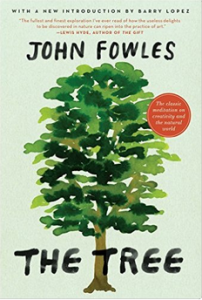 The phrase comes from John Fowles, in his beautiful book The Tree. I picked up this slim volume because a friend who makes his living in literature told me it may be his favorite book ever. Fowles was the English novelist best known for The French Lieutenant’s Woman, but The Tree is his essay—an extended meditation, really—on relating to nature.
The phrase comes from John Fowles, in his beautiful book The Tree. I picked up this slim volume because a friend who makes his living in literature told me it may be his favorite book ever. Fowles was the English novelist best known for The French Lieutenant’s Woman, but The Tree is his essay—an extended meditation, really—on relating to nature.
We feel, or think we feel, nearest to a tree’s “essence” . . . when it chances to stand like us, in isolation; but evolution did not intend trees to grow singly. Far more than ourselves they are social creatures.
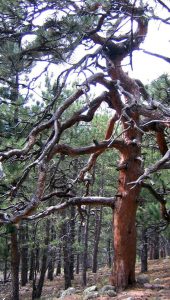 Fowles glimpsed the togetherness of trees decades before science caught up with his social vision and discovered the fungal network connecting a forest. Underground filaments allow older trees to send nutrients and information to younger trees and plants. The very oldest tree, the Mother Tree, acts as the hub, threaded to all, sharing with them what they need to survive. If a Mother Tree is cut down, the other trees fare less well.
Fowles glimpsed the togetherness of trees decades before science caught up with his social vision and discovered the fungal network connecting a forest. Underground filaments allow older trees to send nutrients and information to younger trees and plants. The very oldest tree, the Mother Tree, acts as the hub, threaded to all, sharing with them what they need to survive. If a Mother Tree is cut down, the other trees fare less well.
A community not an ecosystem
Fowles knew the forest connectedness back in 1979:
The true wood, the true place of any kind, is the sum of all its phenomena.
And then that luscious sentence:
They are all in some sense symbiotic, being together in a togetherness of beings.
What an enacting of communal feeling—“being together in a togetherness of beings”! The words inspire a completely different style of relating than the scientific equivalent, ecosystem, conjuring up a machine made of things. In Fowles’s vision nature is above all social. Nature is togetherness.
Focusing on the parts
While nature prefers togetherness, human beings in the Western cultural tradition, Fowles said, focus instead on the parts:
[We] treat the flight of the bird and the branch it flies from, the leaf in the wind and its shadow on the ground, as separate events.
Fowles had no patience for what he thought of as overwrought Victorian science, which felt compelled to name every type and lineage of creature
as if they were unbaptized children and might all go to hell if they were not given individual names.
Being fixated on taxonomy, he said, shows an obsession with nature as a machine. Classifying reveals only parts, not the whole. Engaging in it comes with a cost:
it seriously distorts and limits any worthwhile relationship.
And relationship with nature, Fowles said, is key. He claimed it was key to his fiction—not nature as an abstract intellectual concept but
nature as an experience whose deepest value lies in the fact that it cannot be described by any art . . . including that of words. What I gain most from nature is beyond words.
Any writer who recognizes that their favorite tool is incapable of comprehending the aliveness of nature has my attention!
Relating in the present
Relationship with nature—as relationship with anyone, human or other—means meeting in the present. Yet our urge to classify dooms us, Fowles said, to being stuck in the past. For what is a naming or classifying except forcing a still frame around a flower or plant or animal whose aliveness flows forward in time, forever defying the frame?
He described meeting a particular kind of orchid, a soldier orchid, for the first time.
I fell on my knees before it in a way that all botanists will know. . . . I measured, I photographed, I worked out where I was on the map, for future reference.
His words remind me of how I fall on my knees with every colony of calypso orchids I meet.
When Fowles discovered the soldier orchids he felt happy, experiencing a “first.” Yet five minutes after he’d left the scene, something tugged at him:
I realized I had not actually seen the three plants in the little colony we had found. Despite all the identifying, measuring, photographing, I had managed to set the experience in a kind of present past, a having-looked. . . . I knew I had just fallen, in the stupidest possible way, into an ancient trap.
He had reduced the orchid to a thing.
And then one of the passages that I will forever love this book for:
“Thing” and “then” attract each other. If it is a thing, it was then; if it was then, it is thing. . . . One of the deepest lessons we have to learn is that nature . . . resists this. It waits to be seen otherwise, in its individual presentness and from our individual presentness.
In art as in science
We may think of seeing the parts instead of the whole as the habit of Western science, but Fowles showed that the habit lodged firmly in the minds of Renaissance artists as well. In a fascinating section on painting, he used Pisanello’s The Vision of St. Eustace, painted in 1438–42, to show what he called the “strange cultural blindness” of not being able to see beyond the individuals in nature.
In the painting, St. Eustace, astride a silver horse in the middle of a dark wood, experiences a vision of an enormous stag with an image of the crucified Christ between his antlers.
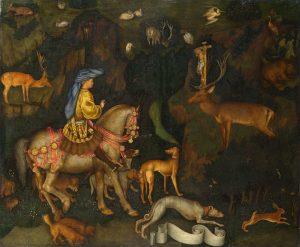
Dogs, deer, swans, egrets, a boar, and other animals and plants populate the scene. Yet in the landscape they bear no relation to one another. Though each individual is lovingly painted in almost photographic detail, Pisanello placed them in an artificial arrangement.
The artifice of the ensemble . . . is almost total. I know no picture that demonstrates more convincingly, and touchingly, this strange cultural blindness. . . . What is truly being hounded, harried and crucified in this ambiguous little masterpiece is not Christ, but nature itself.
Fowles called it
a long-lasting inability to convey the whole as truthfully as the isolated part.
Meeting the woods
In The Tree, a book that might well have been titled The Woods, Fowles saves the best for last. Fittingly, the final ten pages show him visiting a copse of trees in extreme southwest England—a meeting and connecting that the previous eighty pages have been preparation for.
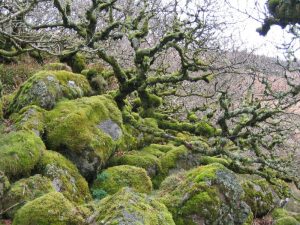
Wistman’s Woods is a strange out-of-time place with moss-covered boulders and gnarled oak trees, a relict forest from Ice Age times. In one of the most beautifully crafted scenes in all of nature writing, Fowles evokes its weird beauty.
The wood waits, as if its most precious sap were stillness. I ask why I, of a species so incapable of stillness, am here.
It’s the kind of writing that might lead a person to put this woods on a bucket list. When I had finished the book I rushed to the Web to see pictures. I include one here, but to repeat Fowles’s point, seeing nature art (or reading nature writing) means relating to a thing, not to a living being.
In the end Fowles rejects all the words, all the naming of his experience with the woods, which is really a misnaming:
It, this namelessness, is beyond our science and our arts because [nature’s] secret is being, not saying. Its greatest value to us is that it cannot be reproduced, that this being can be apprehended only by . . . the living senses and consciousness. . . . But this is nature’s consolation. . . . It can be known and entered only by each, and in its now; not by you through me, . . . only by you through yourself, or me through myself.
It takes being present, as a living being, to meet other living beings. This is how nature, a community, “a togetherness of beings,” honors each individual—by inviting each to meet, to experience, to relate and connect. And above all, to enjoy.















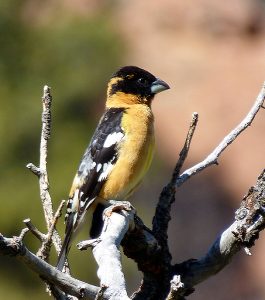 [We] treat the flight of the bird and the branch it flies from, the leaf in the wind and its shadow on the ground, as separate events.
[We] treat the flight of the bird and the branch it flies from, the leaf in the wind and its shadow on the ground, as separate events.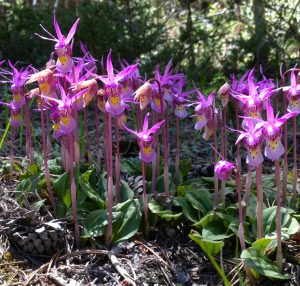
Hi Priscilla
(thanks for the blog follow btw but I will be hitting the road for over a month so a new post in the near future will not be likely)
I tried to impress upon my Biology students that the study of ecology is likely the most complex level of life science study simply because it involves this togetherness of things- the web of life- ecosystems, plant communities and the like. As observers of nature we often take the easy way out by simply identifying things, giving them names, creating lists and having our children do the same things, rather than pay attention to the connections in nature trying to understand the reasons for the things we see. It simplifies our relationship with nature of course and brings order to that complex world and that makes us more comfortable in nature but our ecological decision making (‘Management’) has fallen woefully short and has been largely counterproductive because of the failure to see and understand the larger network of ecological relationships. Nicely written!
Connections. Web of life. Network. Ecological relationships. So important, each of the terms you call attention to! Often, learning the name of a plant or flower or bird stops the inquiry, as if the name were the endpoint of understanding. I know, I’ve done this too. Instead, learning the name might be the beginning of inquiry—into what this creature experiences, how it lives, who it interacts with. So hard to resist the cultural predisposition to see individuals only. Good luck to all the biology teachers out there! And thanks, Don, for dropping by.
Folks, Don is an extraordinary nature photographer, the one who took the photo of the fox on the cover of Kissed by a Fox. Click on his name to find his website of amazing pix of foxes, bears, forests, meadows, rivers, and all seasons.
“The wood waits, as if its most precious sap were stillness.” What a breathtaking sentence. Thank you for reacquainting me with Fowles’ book. It’s wonderful to know that someone else shares my feelings about trees but can express them better than I ever could.
Yes, breathtaking. Lovers of woods and words, like you, can appreciate it! I love how his words took me right there to a place I had never seen. Not just described the place but transported me there.
Thank You!
You’re welcome!